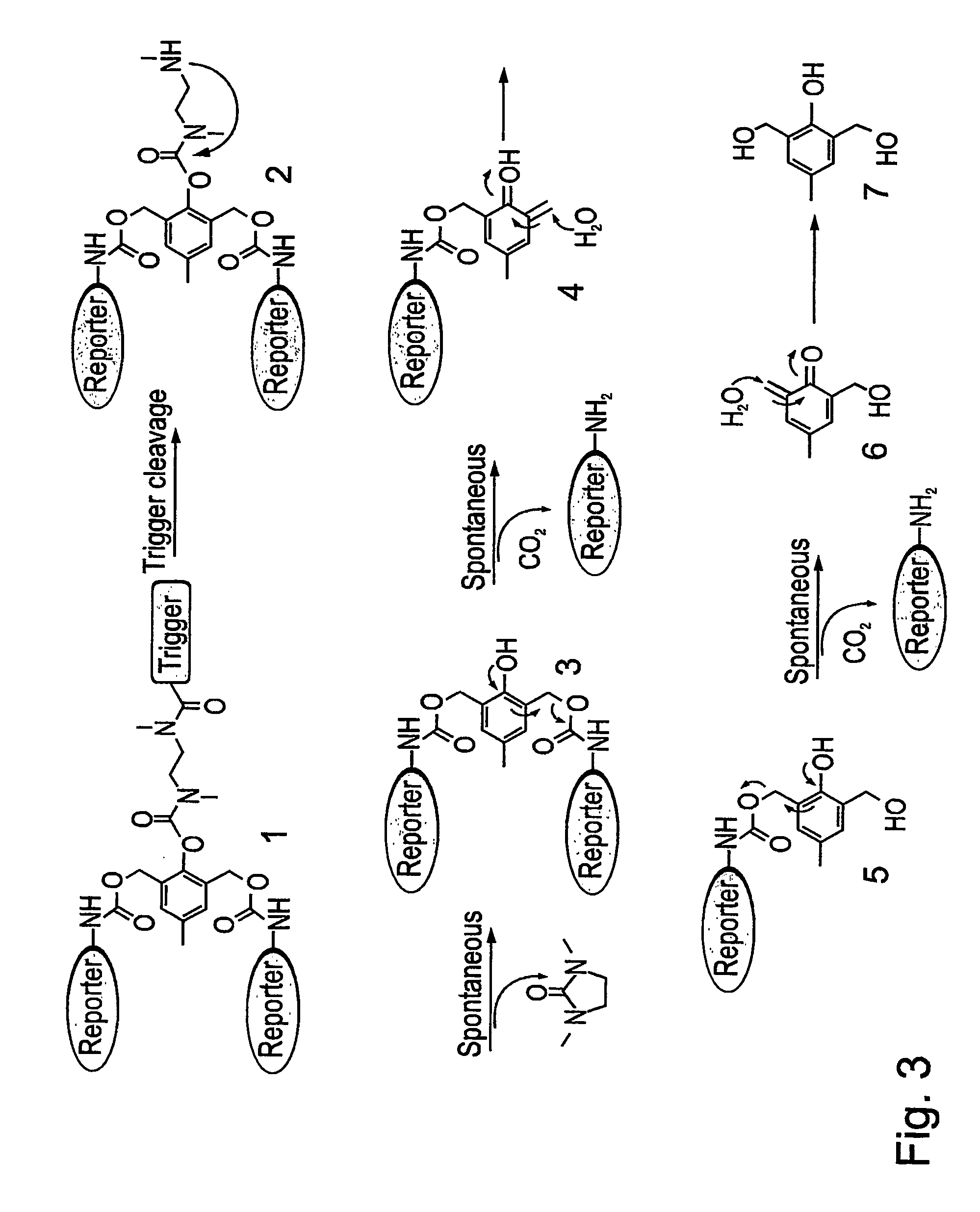Self-immolative dendrimers releasing many active moieties upon a single activating event
- Summary
- Abstract
- Description
- Claims
- Application Information
AI Technical Summary
Benefits of technology
Problems solved by technology
Method used
Image
Examples
example 1
Design and General Synthesis of a G1-Self-Immolative Dendrimer
[0313] As a representative example of a G1-self-immolative dendrimer according to the present invention, a model of such a G1-dendrimer, which is based on the commercially available, tri-functional compound 2,6-bishydroxymethyl-p-cresol, was designed. As is shown in FIG. 3, the model, Compound 1, includes two tail units that are attached through a carbamate linkage to the two benzyl alcohols groups of the basic unit 2,6-bishydroxymethyl-p-cresol (Compound 7), and a trigger unit that is linked to the phenol functionality of the basic unit 2,6-bishydroxymethyl-p-cresol through a short N,N-dimethyletylenediamine spacer. As is farther shown in FIG. 3, according to this model, a cleavage of the trigger unit (denoted as “trigger” in FIG. 3) initiates self-immolative reactions sequence of the cleaved compound, the amine intermediate Compound 2, starting with spontaneous cyclization to form an N,N-dimethylurea derivative and the...
example 2
Design and General Synthesis of G2- and G3-Self-Immolative Dendrimers
[0315] Based on the G1-self-immolative dendrimer model described above, models of higher generations of such dendrimers, e.g., G2- and G3-self-immolative dendrimers, have been designed. Representative examples of a G2-self-immolative dendrimer (Compound 13), and a G3-self-immolative dendrimer (Compound 14), according to the present invention, are presented in FIG. 5. As is shown in FIG. 5, a G2-self-immolative dendrimer is obtained by linking two identical units of G1-dendrimers to the hydroxybenzyl functionalities of the basic cresol (see, Compound 7, FIG. 4) through a double carbamate attachment, using N,N-dimethyletylenediamine as a self-immolative spacer. A G3-self-immolative dendrimer, Compound 14, can be similarly obtained by linking two G2-dendrimers to the hydroxybenzyl groups of the basic cresol. These models have been designed such that the selected linkage between the dendrimeric units (e.g., the N,N-di...
example 3
Design and General Synthesis of a G1-Self-Immolative Dendrimeric Unit Carrying Three Tail Units
[0317] Based of the G1-dendrimer model described hereinabove in Example 1, a model of a G1-dendrimeric compound that carries up to three tail units was also designed. The principle of designing such a compound is based on adding an additional hydroxybenzyl substitution at the para position to the phenolic oxygen of the basic cresol, which enables the additional attachment of a tail unit through a carbamate linkage. As is shown in FIG. 7, the thus formed dendrimeric Compound 16, releases the three tail units upon cleavage of the trigger unit, to give intermediate 17, and a spontaneous cyclization, to give intermediate 18, followed by double 1,4- and one 1,6-quinone methide rearrangements.
[0318] The synthesis of Compound 16 is performed similarly to the synthesis of Compound 1 (presented in FIG. 4), using the tetra-functional starting molecule 2,4,6-trishydroxymethyl-phenol, instead of Com...
PUM
| Property | Measurement | Unit |
|---|---|---|
| Time | aaaaa | aaaaa |
| Time | aaaaa | aaaaa |
| Force | aaaaa | aaaaa |
Abstract
Description
Claims
Application Information
 Login to View More
Login to View More - R&D
- Intellectual Property
- Life Sciences
- Materials
- Tech Scout
- Unparalleled Data Quality
- Higher Quality Content
- 60% Fewer Hallucinations
Browse by: Latest US Patents, China's latest patents, Technical Efficacy Thesaurus, Application Domain, Technology Topic, Popular Technical Reports.
© 2025 PatSnap. All rights reserved.Legal|Privacy policy|Modern Slavery Act Transparency Statement|Sitemap|About US| Contact US: help@patsnap.com



